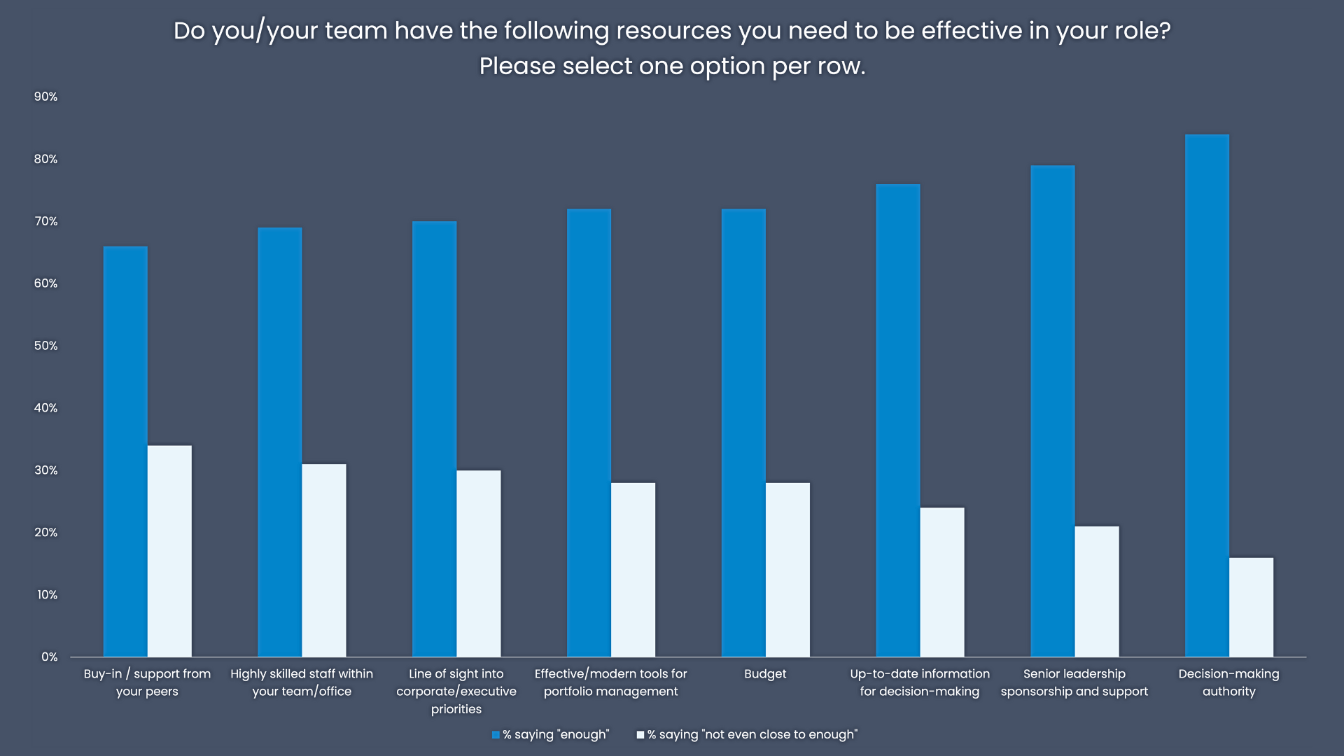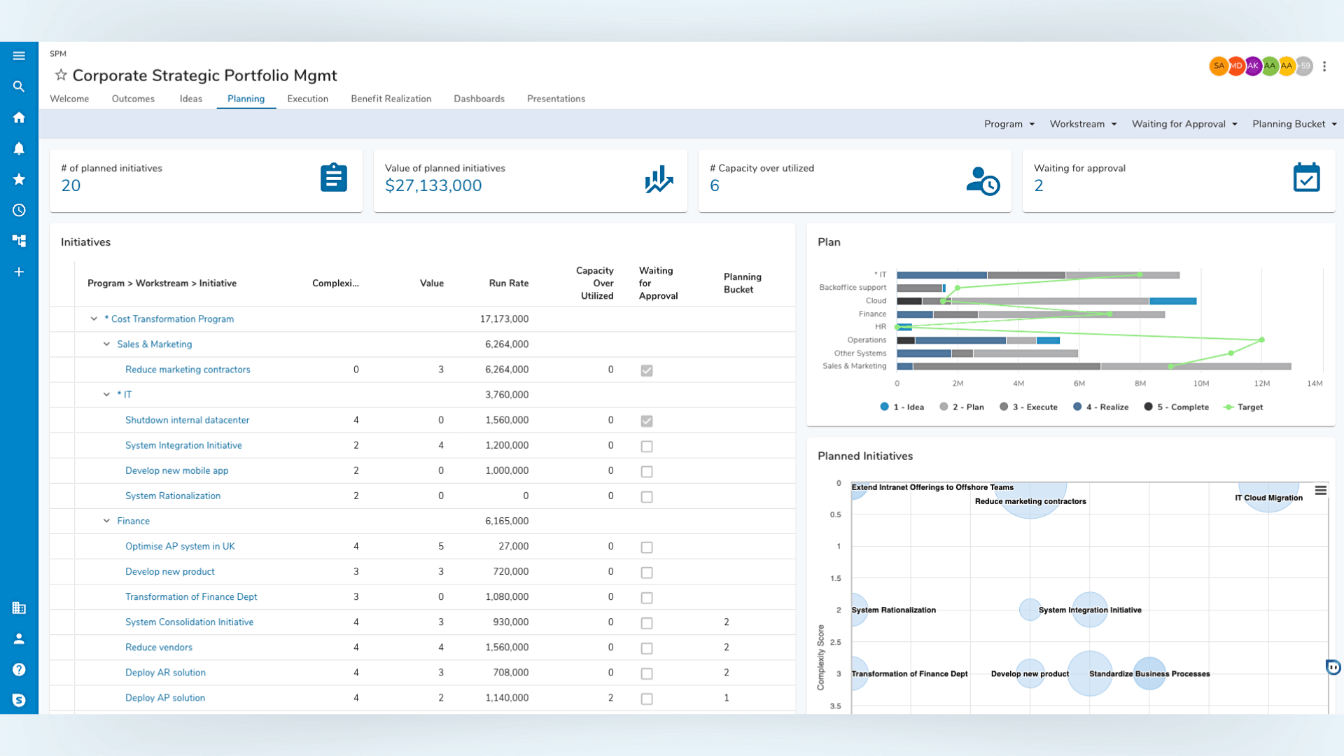When Shibumi surveyed over 250 top professionals in December 2023, we found that 70% of respondents said their companies are undergoing one or more types of business transformation. Furthermore, 83% of respondents reported that their company is simultaneously undergoing three or more transformation efforts. These efforts span across AI/data science, digital, sustainability, and supply chain, highlighting the complex and multi-faceted nature of business transformations today.
Transformation programs are risky and complex. Leaders must set a clear, compelling top-level transformation goal to galvanize their workforce and inspire employees to rise to the challenge. But setting a BIG top-level goal is just the first step. Each organization must also dedicate people to oversee the transformation, structure the transformation roadmap, provide input on the tactical projects, and track progress and delivery of results. People taking on this set of responsibilities are collectively known as the Transformation Office, the Strategy Delivery Office, or the Strategy Execution Office.
Transformation offices and Strategy Delivery offices aren’t brand-new functions within large organizations anymore. They are gaining increasing influence and sway within their organizations as enterprises face greater pressure to improve profitability, innovate, and adapt.
Shibumi’s survey found:
- Scope and Influence: 61% of respondents in transformation and strategy delivery offices said their scope/area of responsibility has increased year over year.
- Team Expansion: 80% of respondents said they plan to expand their team size by one or more headcounts.
If your organization is undergoing some type of transformation and wants to establish a highly effective transformation office, you’ve come to the right place. Below, we’ll share our top survey findings and insights on how organizations set their transformation offices up for success and measure staff performance.
What Resources Do Transformation and Strategy Delivery Offices Need to Be Successful?
For Transformation Offices to excel, they need:
- Clear Vision: Line of sight into corporate/executive priorities
- Leadership Support: Senior leadership sponsorship and support
- Peer support: Buy-in and support from peers in business units, IT and HR functions
- Informed Decision-Making: Access to up-to-date information
- Talented Team: Highly skilled staff within the office/team
- Effective tools: Advanced tools for portfolio management
- Empowered Execution: Assigned budget & decision-making authority
We asked survey respondents whether they felt they had “enough” of each resource listed to be effective in their role or if resources were “not even close to enough”. Respondents cited a lack of buy-in from peers, skilled staff, clear corporate priorities, and effective portfolio management tools as their main challenges.

Strategies for Gaining Support from Function Area Peers
Transformation initiatives are almost always cross-functional. Transformation leaders need to work with their peers from business units, IT, and HR to foster a shared sense of purpose and collective responsibility within the organization. Yet 31% of all respondents said they aren’t getting enough buy-in and support from their peers.
Transformation office professionals looking to build better peer relationships should consider the following strategies:
- Engage Stakeholders: Identify key stakeholders in the departments you need to work with and understand their interests, concerns, and influence. Tailor your communication and engagement strategy to address their specific concerns and goals.
- Communicate Vision: Communicate a clear vision of what the transformation seeks to achieve and if possible, the benefits it provides to each department or key stakeholder.
- Include peers in planning. Ensure that department/function-area leaders are included in the planning process – so they can raise any concerns, provide their perspective, and feel a sense of ownership.
- Showcase Success: Implement initiatives that can quickly show positive results. Communicate each win to build momentum and support for larger initiatives.
- Create Feedback Loops: Create mechanisms for regular feedback from different departments. Be open to adapting plans based on this feedback to meet the needs and concerns of different stakeholders.
Upskilling Staff in Transformation Offices
Transformation offices need highly skilled staff with a variety of competencies. These include, but are not limited to, leadership strategic planning, stakeholder engagement, data analysis & and reporting, communications, project management, and resource management. Yet, 31% of survey respondents said they lack highly skilled staff. Specifically, people called out leadership skills and data analytics skills as two gap areas.
To upskill and develop staff in your transformation office, focus on tailored training programs and self-directed online courses to enhance specific skills. Implement mentorship and coaching for personalized guidance and growth. Support obtaining professional certifications in data analytics, and Agile methodology and emphasize soft skills development, crucial for managing change. Set aside a budget for staff participation in external conferences and networking events for industry insights. Use regular feedback and performance reviews to help in setting personalized development goals. Lastly, offer leadership development programs for those in or aspiring to leadership roles, ensuring a comprehensive approach to skill enhancement and professional growth in your transformation office.
Gaining Line of Sight and Clarity on Corporate Priorities
Our survey found that transformation and strategy delivery leaders often lack clarity on corporate priorities. They need firmer direction from executives to determine how to allocate resources and balance different interests. Executives must be mindful of this situation and mitigate frustration by including transformation/strategy delivery office members in strategy and planning sessions and promptly communicating any strategy or priority changes to them.
Understand the Value of Portfolio Management Tools

On the topic of tools for portfolio management, there was a clear consensus from our respondents that effective portfolio management tools must have the following six product capabilities:
- Program Portfolio Management: Allow portfolio leaders, transformation program managers, and project managers to create a portfolio of initiatives/projects under a single program theme and manage the lifecycle of portfolio initiatives/projects from concept to implementation.
- Strategic Planning: Allow executives and portfolio leaders to create corporate-level goals, themes, value pillars, and objectives, create top-level performance indicators, and build portfolios of initiatives aligned to the enterprise-level objectives.
- Capacity Planning/Resource Allocation: Allow portfolio leaders and managers to make resource allocation forecasts during the planning phase and track actual resource utilization during the execution phase.
- Data Visualization, Pre-built Dashboards, and Reports: Provide executives, portfolio, and project leaders with valuable data visualizations and out-of-the-box reports and dashboards with the level of detail appropriate to each role. Empower different stakeholders to make faster, more informed decisions.
- Benefit Tracking (measuring financial benefits): Show benefit forecasts and actuals to stakeholders at the enterprise, portfolio, initiative, and project levels. The software flags initiatives that are not delivering the expected benefit.
- Integrations between portfolio management software and an organization’s project management, business intelligence, and ERP systems are considered “must-haves.”
On the other hand, respondents did not reach a clear consensus on the relative criticality of other product capabilities, including roadmap planning, portfolio budgeting, value stream mapping, enterprise architecture, scenario planning, and ideal intake management. Lack of consensus may reflect the diversity of organizations’ needs. For instance, functionality such as scenario planning only starts to become beneficial once an organization has achieved a baseline level of portfolio management maturity. Organizations may also have good enough tools already for specific processes, such as portfolio budgeting.
Success Measures for Transformation Offices
In Shibumi’s 2024 SPM Benchmark Insights Survey, we asked respondents, “How is your team/office’s performance measured?” Respondents could select from a list of provided metrics and select as many as are being used.
We learned that modern transformation offices use various quantitative and qualitative measures to measure their contribution to transformation success. They evaluate success from multiple lenses, including direct transformation goal achievement, customer satisfaction, process improvement, and employee satisfaction.
Here’s what we learned:
1. Direct transformation goal achievement is the most used barometer of performance.
More than half of all respondents (54%) reported being measured on transformation goal achievement (e.g., cost savings for a cost take-out program; ESG targets achievement).
2. Technical and soft skills matter
More than half (54%) said the skill/growth/improvements demonstrated by their team are key performance indicators for them.
Transformation leaders know that a highly skilled team, well-versed in strategic planning, data analysis, portfolio/project management, and stakeholder engagement, is a major swing factor in transformation success. Many leaders are intentional about upskilling their team.
3. Classic project management effectiveness metrics retain importance
53% of respondents said they track such traditional project success metrics such as the percentage of projects delivered on time and budget adherence.
4. Process improvement is worth measuring
52% of respondents wisely recognized that transforming their organization requires people to let go of what’s not working and adopt new processes. They push stakeholders to adopt standardized methodologies and drive efficiencies in resource allocation, prioritization, and reporting processes.
Wrap up
This article highlights the resources and crucial success elements organizations need to achieve their desired transformation outcome. With the right resources, strategies, and tools, Transformation Offices will drive significant value into the business. Read our full 2024 SPM Benchmark Survey and Insights Report for more findings and recommendations.

